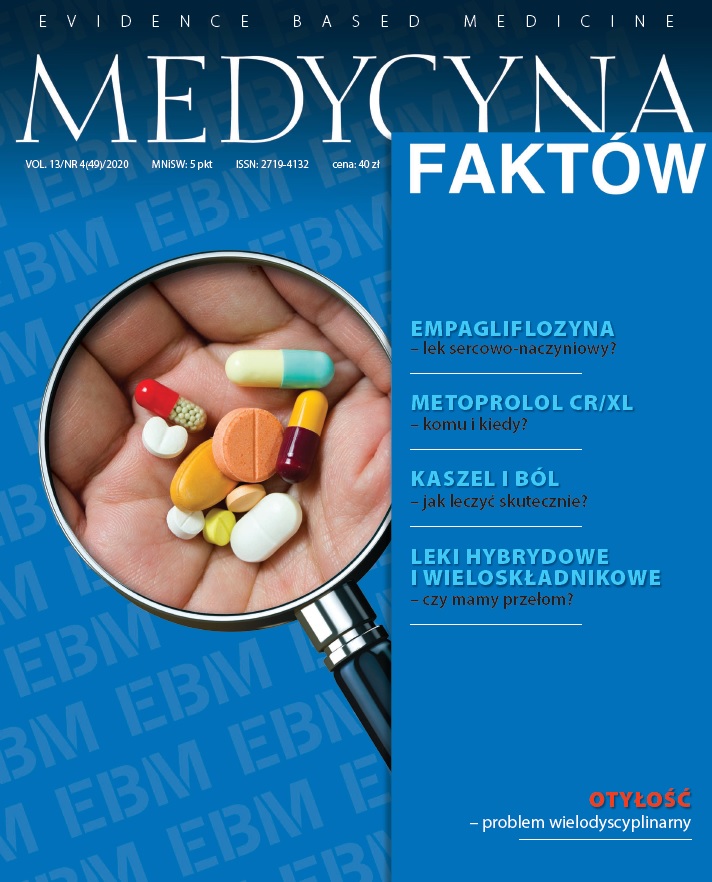Miejsce bromku ipratropium w farmakoterapii kaszlu w przebiegu infekcji wirusowych układu oddechowego Artykuł przeglądowy
##plugins.themes.bootstrap3.article.main##
Abstrakt
Kaszel jest odruchem mimowolnym lub wywołanym przez świadomie wytężony manewr wydechowy polegający na nagłym wydaleniu powietrza z dolnych dróg oddechowych, którego celem jest usunięcie zalegającej wydzieliny lub ciała obcego. Przy wyborze leku stosowanego w terapii kaszlu należy uwzględnić liczne elementy mające w swoim założeniu potencjalizować skuteczność leczenia oraz zmniejszyć ryzyko występowania działań niepożądanych. Jednym z leków, który może być stosowany w objawowym leczeniu kaszlu suchego, jest bromek ipratropium.
##plugins.themes.bootstrap3.article.details##
Jak cytować
Woroń , J. (2020). Miejsce bromku ipratropium w farmakoterapii kaszlu w przebiegu infekcji wirusowych układu oddechowego. Medycyna Faktów , 13(4(49), 445-448. https://doi.org/10.24292/01.MF.0420.9
Numer
Dział
Artykuły
Copyright © by Medical Education. All rights reserved.
Bibliografia
1. Jones BF, Stewart MA. Duration of cough in acute upper respiratory tract infections. Aust Fam Physician. 2002; 31(10): 971-3.
2. Chung KF, Pavord ID. Prevalence, pathogenesis, and causes of chronic cough. Lancet. 2008; 371(9621): 1364-74. https://doi.org/10.1016/S0140-6736(08)60595-4.
3. Higenbottam T. Chronic cough and the cough reflex in common lung diseases. Pulm Pharmacol Ther. 2002; 15(3): 241-7. https://doi.org/10.1006/pupt.2002.0341.
4. Widdicombe J, Fontana G. Cough: what’s in a name? Eur Respir J. 2006; 28(1): 10-5. https://doi.org/10.1183/09031936.06.00096905.
5. Morice AH, Fontana GA, Belvisi MG et al. European Respiratory Society (ERS). ERS guidelines on the assessment of cough. Eur Respir J. 2007; 29(6): 1256-76. https://doi.org/10.1183/09031936.00101006.
6. Irwin RS, Pratter MR, Brightling CE et al. Diagnosis and management of cough executive summary: ACCP evidence-based clinical practice guidelines. Chest. 2006; 129(1 suppl): 1S-23S. https://doi.org/10.1378/ chest.129.1_suppl.1S.
7. Morice AH, Fontana GA, Sovijarvi ARA et al. The diagnosis and management of chronic cough. Eur Respir J. 2004; 24(3): 481-92. https://doi.org/10.1183/09031936.04.00027804.
8. Pratter MR. Chronic upper airway cough syndrome secondary to rhinosinus diseases (previously referred to as postnasal drip syndrome): ACCP evidence-based clinical practice guidelines. Chest. 2006; 129(1 suppl): 63S-71S. https://doi.org/10.1378/chest.129.1_ suppl.63S.
9. De Diego A, Martínez E, Perpiñá M et al. Airway inflammation and cough sensitivity in cough-variant asthma. Allergy. 2005; 60(11): 1407-11. https://doi.org/10.1111/j.1398-9995.2005.00609.x.
10. Wirfs MJ. Prescribing Drug Therapy 2020. Springer Publishing Company, New York 2020.
11. Tymiński R, Woroń J (ed). Niekorzystne interakcje leków, aspekty kliniczne i prawne. Medical Tribune Polska, Warszawa 2020.
12. Pounsford JC, Birch MJ, Saunders KB. Effect of bronchodilators on the cough response to inhaled citric acid in normal and asthmatic subjects. Thorax. 1985; 40(9): 662e7.
13. Holmes PW, Barter CE, Pierce RJ. Chronic persistent cough: use of ipratropium bromide in undiagnosed cases following upper respiratory tract infection. Respir Med. 1992; 86: 425-9.
14. Zanasi A, Lecchi M, Del Forno M et al. A randomized, placebo-controlled, double-blind trial on the management of post-infective cough by inhaled ipratropium and salbutamol administered in combination. Pulm Pharmacol Ther. 2014; 29(2): 224-32.
15. Morice AH. Epidemiology of cough. Pulm Pharmacol Ther. 2002; 15: 253-9.
2. Chung KF, Pavord ID. Prevalence, pathogenesis, and causes of chronic cough. Lancet. 2008; 371(9621): 1364-74. https://doi.org/10.1016/S0140-6736(08)60595-4.
3. Higenbottam T. Chronic cough and the cough reflex in common lung diseases. Pulm Pharmacol Ther. 2002; 15(3): 241-7. https://doi.org/10.1006/pupt.2002.0341.
4. Widdicombe J, Fontana G. Cough: what’s in a name? Eur Respir J. 2006; 28(1): 10-5. https://doi.org/10.1183/09031936.06.00096905.
5. Morice AH, Fontana GA, Belvisi MG et al. European Respiratory Society (ERS). ERS guidelines on the assessment of cough. Eur Respir J. 2007; 29(6): 1256-76. https://doi.org/10.1183/09031936.00101006.
6. Irwin RS, Pratter MR, Brightling CE et al. Diagnosis and management of cough executive summary: ACCP evidence-based clinical practice guidelines. Chest. 2006; 129(1 suppl): 1S-23S. https://doi.org/10.1378/ chest.129.1_suppl.1S.
7. Morice AH, Fontana GA, Sovijarvi ARA et al. The diagnosis and management of chronic cough. Eur Respir J. 2004; 24(3): 481-92. https://doi.org/10.1183/09031936.04.00027804.
8. Pratter MR. Chronic upper airway cough syndrome secondary to rhinosinus diseases (previously referred to as postnasal drip syndrome): ACCP evidence-based clinical practice guidelines. Chest. 2006; 129(1 suppl): 63S-71S. https://doi.org/10.1378/chest.129.1_ suppl.63S.
9. De Diego A, Martínez E, Perpiñá M et al. Airway inflammation and cough sensitivity in cough-variant asthma. Allergy. 2005; 60(11): 1407-11. https://doi.org/10.1111/j.1398-9995.2005.00609.x.
10. Wirfs MJ. Prescribing Drug Therapy 2020. Springer Publishing Company, New York 2020.
11. Tymiński R, Woroń J (ed). Niekorzystne interakcje leków, aspekty kliniczne i prawne. Medical Tribune Polska, Warszawa 2020.
12. Pounsford JC, Birch MJ, Saunders KB. Effect of bronchodilators on the cough response to inhaled citric acid in normal and asthmatic subjects. Thorax. 1985; 40(9): 662e7.
13. Holmes PW, Barter CE, Pierce RJ. Chronic persistent cough: use of ipratropium bromide in undiagnosed cases following upper respiratory tract infection. Respir Med. 1992; 86: 425-9.
14. Zanasi A, Lecchi M, Del Forno M et al. A randomized, placebo-controlled, double-blind trial on the management of post-infective cough by inhaled ipratropium and salbutamol administered in combination. Pulm Pharmacol Ther. 2014; 29(2): 224-32.
15. Morice AH. Epidemiology of cough. Pulm Pharmacol Ther. 2002; 15: 253-9.
